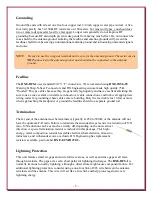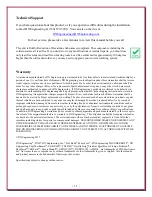
- 2 -
cables have the distinct advantage of automatically sealing small accidental cuts or lacerations of
the jacket. Flooding also prevents shield contamination and can be direct-buried. To ensure
weatherproof connections, use
Snap-N-Seal connectors. DX Engineering part number
DXE-SNS6-
25
contains 25 Snap-N-Seal connectors. The Snap-N-Seal connectors cannot be installed with
normal crimping tools or pliers, so an installation tool like the
DXE-SNS-CT1
is essential for
proper connector installation.
Additional Requirements
Please note you will need the following items (not included in this package) to install and operate
the
DXE-BFS-1
antenna:
Antenna wire:
You will need a minimum of 3/8 wavelength of wire of any gauge between #8 and
#20.
Ground rods:
Use at least one 5-ft copper rod.
Insulators and supports:
Insulators and supports are required to support the antenna wire 5 to 10 feet
above ground. Supports can be metallic but the antenna wire must be insulated from them.
Specifications
Operating Frequency
:
100 KHz to 30 MHz
Input Impedance
:
400-500 Ω
Output Impedance
:
30-100 Ω (75 Ω recommended)
Common Mode Isolation
: 20-30 dB (feedline and antenna)
Power Handling:
20 watts continuously or 200 watts for 5 seconds
Termination Resistance
:
400-500 Ω
Installation
We strongly suggest that you read the entire
DXE-BFS-1
manual before installing the antenna, and
make sure you understand the concepts outlined in the sidebar (below) that are critical to proper
operation.
Isolation
The
DXE-BFS-1
operates on the principle of a transformer with isolated antenna and feedline
connections. This prevents the feedline from contributing unwanted electrical noise or signals to the
receiver. Many antenna enthusiasts unwittingly connect their feedline to their matching system
housing, not realizing that the practice simply makes the antenna longer and increases unwanted
signals. The
DXE-BFS-1
solves this problem by insulating the connection lugs from the housing,
which also isolates the antenna from the feedline.












